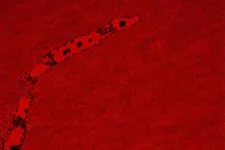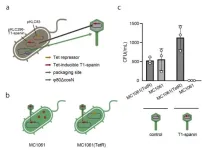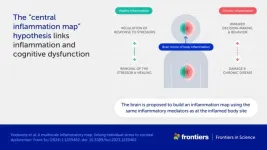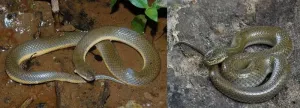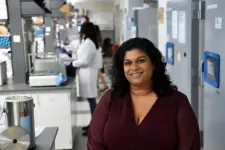(Press-News.org) We experience turbulence every day: a gust of wind, water gushing down a river or mid-flight bumps on an airplane.
Although it may be easy to understand what causes some kinds of turbulence — a felled tree in a river or a bear splashing around for salmon — there is now evidence that a very small disturbance at the start can have dramatic effects later. Instead of a tree, think of a twig — or even the swerving motion of a molecule.
University of California San Diego Chancellor’s Distinguished Professor of Physics Nigel Goldenfeld, along with his former student Dmytro Bandak, and Professors Alexei Mailybaev and Gregory Eyink, has shown in theoretical models of turbulence that even molecular motions can create large-scale patterns of randomness over a defined period of time. Their work appears in Physical Review Letters.
The Butterfly Effect
A butterfly flaps its wings in Brazil which later causes a tornado in Texas. Although we may commonly use the phrase to denote the seeming interconnectedness of our own lives, the term “butterfly effect” is sometimes associated with chaos theory. Goldenfeld said their work represents a more extreme version of the butterfly effect, first described by mathematician and meteorologist Edward Lorenz in 1969.
“What we’ve learned is that in turbulent systems, a very small disturbance at one point will have an amplified effect at a finite point in the future, but through a mechanism that is faster than chaos.”
Although the mathematical mechanism for this amplification, known as spontaneous stochasticity, was discovered about 25 years ago, Goldenfeld noted, “The fact that the random motion of molecules, responsible for the everyday phenomenon of temperature, could generate spontaneous stochasticity was not known before our work.”
Thinking back on the twig in the river: while you might notice a small disturbance where the water flows over the twig, you wouldn’t expect it to create a great deal of turbulence (via eddies and swirls) downstream. Yet that is precisely what Goldenfeld’s paper shows. He explains that the mechanism is known as spontaneous stochasticity, because the randomness arises even though the fluid motion was expected to be predictable. Furthermore, it would be impossible to pinpoint the twig that had originally set the eddies and swirls in motion. In fact, there may be no disturbance in the water flow where the twig is located at all.
The team’s findings also showed that spontaneous stochasticity happens regardless of the initial disturbance. Whether it’s a twig, a pebble or a clod of dirt, the randomness you get on a large scale is the same. In other words, the randomness is intrinsic to the process.
The team used thermal noise as the system for their calculations because it is always present — noticeable in the hissing of your amplifier. That noise is the sound of electrons moving around inside your electronics. In a fluid, it is the molecules that are moving around instead of electrons.
Although the Navier-Stokes equation is the standard model for computing turbulent flows, it was computationally unfeasible to use the full fluid equations to simulate the very extreme turbulent events required to convincingly demonstrate the team’s claims. Instead, they used a simplified equation, and in doing so showed that a disturbance on the scale of microns (a millionth of a meter) could cause entire fluid systems to exhibit spontaneous stochasticity in a way that did not depend on the source of the disturbance.
“For now, this will have to do” said Goldenfeld, “but we hope that future supercomputer calculations will be able to confirm our results using the full fluid equations.”
Predicting the Future and the Past
“There exists a fundamental limit to what can be predicted with turbulence,” stated Goldenfeld. “You see this with weather forecasts; there is always a fundamental source of randomness. The precise sense in which this unpredictability was inevitable wasn’t fully understood before our work.”
It’s that randomness that makes it so hard to accurately predict the weather more than a few hours in advance. Meteorological stations sample weather in select locations and computer simulations stitch them together, but without knowing the exact weather everywhere right now, it’s hard to predict the exact weather everywhere in the future. This paper hints at the possibility that fundamental limits will always exist because randomness will always show up.
There may also be implications in astrophysics research. Scientists already understand that computer simulations of how galaxies are formed and how our universe evolved are sensitive to noise. Often the behaviors of stars, planets and galaxies cannot be easily explained and may be attributed to the kinds of microscopic noise that Goldenfeld and his colleagues have uncovered.
Full list of authors: Dmytro Bandak (University of Illinois at Urbana-Champaign), Alexei Mailybaev (Instituto de Matemática Pura e Aplicada - IMPA, Brazil), Gregory L. Eyink (The Johns Hopkins University) and Nigel Goldenfeld (UC San Diego).
This work was partially supported by the Simons Foundation (663054 (G.E.) and 662985(N.G.)), the National Council for Scientific and Technological Development in Brazil (CNPq grant 308721/2021-7) and the Carlos Chagas Filho Foundation for Research Support in Brazil (FAPERJ grant E-26/201.054/2022).
END
You didn’t see it coming: the spontaneous nature of turbulence
New research shows turbulent flows can be caused by minute triggers
2024-03-12
ELSE PRESS RELEASES FROM THIS DATE:
Advancing plant biology with breakthroughs in single-cell RNA sequencing
2024-03-12
Recent breakthroughs in single-cell RNA sequencing (scRNA), such as the recently developed “RevGel-seq” method, has revolutionized plant cell analysis. This technique, independent of special instruments, streamlines processes and resolves protoplast isolation challenges. Now, a multinational team of researchers review this and other such recent advances in plant scRNA sequencing with the intention of providing guidance for facilitating the appropriate selection of scRNA methods for different plant samples.
In the world of plant biology, understanding ...
Study provides new insights into deadly acute respiratory distress syndrome (ARDS)
2024-03-12
MINNEAPOLIS / ST. PAUL (03/12/2024) - Researchers at the University of Minnesota Twin Cities may have discovered a mechanical explanation for instability observed in the lungs in cases of acute respiratory distress syndrome (ARDS), particularly in the aftermath of respiratory illnesses such as COVID-19 or pneumonia.
The research was recently published in the Proceedings of the National Academy of Sciences (PNAS), a peer reviewed journal of the National Academy of Sciences.
Currently, there is no known cure for ARDS, a life-threatening ...
Valorization of depolymerized lignin using microorganisms
2024-03-12
Lignin is an abundant natural polymer which is eliminated as a byproduct in the pulp and paper industry. A recent review article explored different microbial processes available for sustainable lignin valorization, yielding not only environmental, but also economic benefits. Researchers highlighted the current advancements as well as challenges faced while using naturally occurring and engineered microbes to transform depolymerized lignin into valuable high-value products.
The increasing focus on transitioning to a low-carbon ...
Exploring the bactericidal activity of T1-spanin against drug-resistant bacteria
2024-03-12
Given the worldwide prevalence of drug-resistance bacteria, the research fraternity is on the lookout for alternative bactericidal treatment approaches. In a recent study, Japanese researchers have now compared bacteriophage-derived enzymes for combating drug-resistant bacteria. Examination of T1-spanin revealed that it shows superior bactericidal activity against various strains, including E.coli. Furthermore, a novel phage-based technology effectively delivers T1-spanin genes into target bacteria. This breakthrough holds promise for the development of ...
Chronic stress and inflammation linked to societal and environmental impacts in new study
2024-03-12
From anxiety about the state of the world to ongoing waves of Covid-19, the stresses we face can seem relentless and even overwhelming. Worse, these stressors can cause chronic inflammation in our bodies. Chronic inflammation is linked to serious conditions such as cardiovascular disease and cancer – and may also affect our thinking and behavior.
A new hypothesis published in Frontiers in Science suggests the negative impacts may extend far further.
“We propose that stress, ...
Rice paddy snake diversification was driven by geological and environmental factors in Thailand, molecular data suggests
2024-03-12
LAWRENCE, KANSAS — A University of Kansas study of rice paddy snakes in Southeast Asia gives key details to their diversification and natural history, adding molecular evidence that the rise of the Khorat Plateau and subsequent environmental shifts in Thailand may have altered the course of the snakes’ evolution some 2.5 million years ago. The findings were published today in the journal Scientific Reports.
Researchers say the implications could help tell the story of diversification more broadly in the region.
“This paper concerns mud snakes ...
Mars attracts: How Earth’s interactions with the red planet drive deep-sea circulation
2024-03-12
Scientists from the Universities of Sydney and Sorbonne University have used the geological record of the deep sea to discover a connection between the orbits of Earth and Mars, past global warming patterns and the speeding up of deep ocean circulation.
They discovered a surprising 2.4-million-year cycle where deep currents wax and wane which, in turn, is linked to periods of increased solar energy and a warmer climate.
The study, published in Nature Communications, tackles the questions of how geological-timescale climate ...
The surprising effect of presence hallucinations on social perception
2024-03-12
If you had to estimate the number of people in a room, without counting them one-by-one, by nature you would overcount them. That’s because, simply put from a Darwinian perspective of how we have evolved, it’s better to overcount potentially harmful agents and predators than to underestimate them. This overcounting social behaviour is shown to be true in humans as well as animals. It’s certainly better to detect too many tigers (even if absent) during a jungle excursion than to miss a hungry one!
Now, EPFL neuroscientists show that if you experience hallucinations, especially ...
Seismological study shows ancient lower mantle flow field under Philippine sea plate
2024-03-12
Researchers from China and Japan have discovered distinct characteristics of the lower mantle flow field. They investigated seismic anisotropy in the upper part of the lower mantle beneath the Philippine Sea Plate (PSP) and found that the ancient lower mantle flow field is still preserved there.
The study was published in Nature Geoscience.
The lower mantle is an important layer of the Earth and may play an important role in the evolution and material cycling of Earth's interior. It is generally believed to be not only the final destination of subducted slabs, ...
Age-related changes in skin may contribute to melanoma metastases
2024-03-12
*EMBARGOED UNTIL TUESDAY, MARCH 12, AT 6 A.M. ET
Age-related changes that cause the skin to stiffen and become less elastic may also contribute to higher rates of metastatic skin cancer in older people, according to research by investigators from the Johns Hopkins Kimmel Cancer Center.
The study, published March 12 in Nature Aging, shows that increased stiffness in aging skin increases the release of a protein called ICAM1. Increased ICAM1 levels stimulate blood vessel growth in the tumor, helping it grow. It also makes the blood vessels “leaky,” enabling tumor cells ...
LAST 30 PRESS RELEASES:
From fungi to brain cells: one scientist's winding path reveals how epigenomics shapes neural destiny
Schizophrenia and osteoporosis share 195 genetic loci, highlighting unexpected biological bridges between brain and bone
Schizophrenia-linked genetic variant renders key brain receptor completely unresponsive to both natural and therapeutic compounds
Innovative review reveals overlooked complexity in cellular energy sensor's dual roles in Alzheimer's disease
Autism research reframed: Why heterogeneity is the data, not the noise
Brazil's genetic treasure trove: supercentenarians reveal secrets of extreme human longevity
The (metabolic) cost of life
CFRI special issue call for papers: New Frontiers in Sustainable Finance
HKU Engineering scholar demonstrates the smallest all-printed infrared photodetectors to date
Precision empowerment for brain "eavesdropping": CAS team develops triple-electrode integrated functional electrode for simultaneous monitoring of neural signals and chemical transmitters during sleep
Single-capillary endothelial dysfunction resolved by optoacoustic mesoscopy
HKU three research projects named among ‘Top 10 Innovation & Technology News in Hong Kong 2025’ showcasing excellence in research and technology transfer
NLRSeek: A reannotation-based pipeline for mining missing NLR genes in sequenced genomes
A strand and whole genome duplication–aware collinear gene identification tool
Light storage in light cages: A revolutionary approach to on-chip quantum memories
Point spread function decoupling in computational fluorescence microscopy
BacPhase: Long-insert paired-end sequencing for bin marker construction and genome phasing
GmWOX1 regulates the mediolateral polarity of compound leaves in soybean
ChargeFabrica: An open-source simulation tool that aims to accelerate search for high performance perovskite solar cells
High levels of ADAR overexpression induce abundant and stochastic off-target RNA editing in rice protoplasts
On-demand upgraded recycling of polyethylene and construction of sustainable multifunctional materials based on the "LEGO" strategy
New "Stomata in-sight" system allows scientists to watch plants breathe in real-time
Anorexia nervosa may result in long-term skeletal muscle impairment
Narrative-based performance reviews deemed fairest by employees
New insights reveal how advanced oxidation can tackle emerging water pollutants
New review shows how biomass can deliver low-carbon gaseous fuels at scale
Climate change is quietly rewriting the world’s nitrogen cycle, with high stakes for food and the environment
Study finds SGLT-2 inhibitors linked to lower risk of diabetic foot nerve damage
Microbes may hold the key to brain evolution
Study examines how the last two respiratory pandemics rapidly spread through cities
[Press-News.org] You didn’t see it coming: the spontaneous nature of turbulenceNew research shows turbulent flows can be caused by minute triggers

